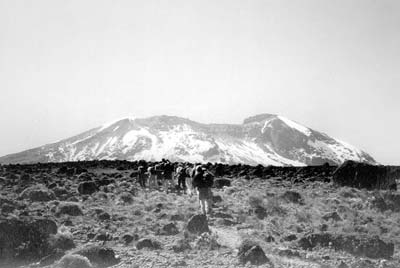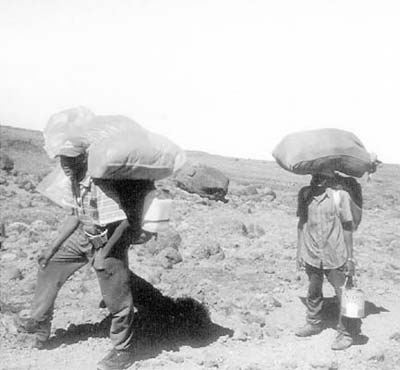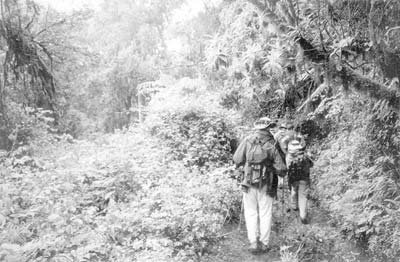Viewfinders — Mt. Kilimanjaro
by Tyler Morse, New York, NY
The top of Mt. Kilimanjaro in Tanzania was my goal, so in May ’02 I joined 11 others in Amsterdam and we flew to Nairobi, where we boarded a bus and rode for seven hours through southern Kenya and then northern Tanzania to the Marangu Hotel in Moshi. This was the embarkation site for our climb up the mountain.
The Marangu Hotel (P.O. Box 40, Moshi, Kilimanjaro Region, Tanzania, East Africa; phone 255-27-275-6594 or 255-27-275-6361, fax 255-27-275-6591 or e-mail marangu@africaonline.co.tz) stands on 12 acres of well-laid-out gardens with exotic trees and scrubs on the slopes of Mt. Kilimanjaro.
We were checked in by the owners, Desmond and Seamus Brice-Bennett, who certified that we had the proper gear for the trek. They took care of us and arranged everything before we arrived; the entire trip was booked through e-mail and they were totally accommodating. The hotel employs professional guides who work only for them and have been equipping and preparing mountaineers for 40 years.
We would be hiking the Machame Route instead of the Marangu Route (which most climbers use). The Marangu is an all-hut route with beds, and it is considerably shorter than the Machame. The Machame uses tents and has more exotic scenery at each night’s stop.
On day one, our group of 12 hiked for six hours through rainforest along a single track to our first night’s camping site.
Our group, which included six women, had six guides and some 30 porters. The porters carried our gear, food, tents, cooking supplies and all else we needed. The guides in charge received $80 each; other guides, $60, and porters, $20. Our tents were set up for us and our meals cooked.
It was cold, about 35°F, so there was frost and ice at night and in the mornings.
On day two we got up early and hiked to the Shira Plateau, eventually camping at 12,000 feet after another six hours of hiking. We played cards at night, but it was so cold we were normally in bed by 9 p.m.
On day three we hiked from the Shira Hut to the Barranco Hut at about 13,000 feet. During the 5- to 6-hour hike we reached 15,000 feet near the Lava Tower but then dropped back into the valleys. The views were spectacular that day as we walked at the bottom of the mountain, peering up at the glacier fields coming down from the summit. That night we had to call the card game, as it was so cold one of our group got a nosebleed.
Next was a short, 3-hour hiking day that started with the steep ascent of the Barranco Wall, which had us scrambling on hands and knees up the side of a cliff. We went in and out of three valleys before arriving at our camping area near a running stream. There was an ugly trash problem at this site — garbage everywhere. Rain started here in mid-afternoon and did not let up all night. We hoped it would not rain or snow like this on summit day.
Day five was also a 3-hour hiking day. It was foggy all day and visibility was very poor. I went ahead of my group for the first time and beat them to the Barafu Hut by one hour. I felt a bit guilty. We arrived to a clear, crisp night, and the summit became visible shortly before sunset. We went to bed early that night as we were to make a
12:30 a.m. departure for the summit.
Day six was summit day. We awoke at 11:50 p.m. the night before to eat lightly prior to our 12:30 a.m. departure. Attire was super-thick socks, leg gaiters, long underwear, ski pants, ear/head warmers, fleece, goggles and jacket. The guides’ preparation was very deliberate, so we did not leave until 1 a.m.
After three hours of hiking we reached the volcano’s rim and turned left at Stella’s Point, summitting at the Roof of Africa at
5:10 a.m. We were at 19,341 feet at a spot called Uhuru Peak. (Uhuru is the Swahili word for “freedom.”) It was still dark — not a sign of sunrise until 5:45 a.m.
We hiked down the dirt cliff at the far end of the Roof of Africa and past the 15- to 20-story glacier. I wanted to stay, but the cold of -10°F was too much for me. We looked down into the live, still-smoldering walls of the volcano crater and the very deep ash pit. The sight of the crater was fascinating geologically. I felt like we were on the moon.
Then the sun came up. Sunrise viewed from the highest point in Africa is unparalleled — vibrant, beautiful, exotic, mesmerizing.
We arrived back at the Barafu Hut about 9:30 a.m. and continued down the mountain to 10,000 feet and the Mweka Hut, which was some four-plus hours’ hiking (very taxing after the early part of our day). It was here that we spent our last night on the mountain.
On day seven we woke early, as we were eager to get back to the Marangu to shower and eat some non-seven-day-old chicken. We left at 8 a.m. and walked four more hours through mud in the rainforest to the gate. From there we were driven back to the Marangu Hotel, arriving at 3 p.m. The ceremony upon our return started shortly thereafter.
The climb provided all of us with a great feeling of accomplishment, as all 12 of us had attained our goal. We had defied the odds. The rate of failure to attain the summit of Kilimanjaro is about one in three.
For each of us, the cost for two nights at the hotel and six days of food, our guides, porters, lodging on the mountain, etc., was $1,100 plus $83 in tips.
On our last night in Nairobi we treated ourselves to an all-you-can-eat dinner at the Carnivore (phone 254 20 602 764 or e-mail reservations@carnivore.co.ke), off Langata Road — $18, with reservations essential.
Only about 15 minutes from central Nairobi, the Carnivore is located in the middle of nowhere. Taxi drivers know of it, and the cab ride out costs about $2. It’s worth it to keep the taxi waiting while you eat, as taxis are hard to get out there for the return to town.
Meats were roasted on traditional Maasai swords over a huge charcoal pit and then waiters brought them around the tables, slicing off onto our plates as much as we could eat. Choices that day included our fill of wildebeest, gazelle, ostrich, crocodile, zebra, elephant and giraffe.
They gave each diner a small white flag to display when satiated. All of us got our money’s worth at the marathon feast, and the white flags were raised.




